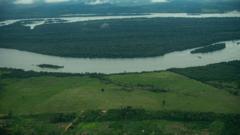The Australian Institute of Marine Science reports that the Great Barrier Reef has experienced the largest annual coral cover decline on record, largely due to climate change, alongside natural disasters and increasing invasive species. Experts warn of the reef's fragile future and call for urgent climate action to prevent irreversible damage.
Great Barrier Reef Faces Record Coral Decline Amid Climate Crisis

Great Barrier Reef Faces Record Coral Decline Amid Climate Crisis
A new report reveals unprecedented coral loss in the Great Barrier Reef, as climate change continues to devastate one of the world's most important marine ecosystems.
Despite numerous efforts to monitor and protect it, the Great Barrier Reef has recorded its worst annual decline in coral cover since monitoring began nearly four decades ago. The Australian Institute of Marine Science (AIMS) recently revealed that both northern and southern sections of this iconic reef have faced their most severe bleaching events on record.
Recent weather events such as tropical cyclones, coupled with outbreaks of crown-of-thorns starfish—predators of coral—have compounded the devastation. However, the analysis highlights climate change as the primary driver of coral decline. AIMS cautions that the reef may reach a critical point where its coral cannot recover fast enough due to repeated environmental shocks, leading towards a "volatile" future.
AIMS conducted health surveys on 124 coral reefs between August 2024 and May 2025 and noted alarming trends since commencing research in 1986. Often referred to as the world’s largest living structure, the Great Barrier Reef spans an extensive 2,300 kilometers (1,429 miles) and supports around 25% of all marine species. The report indicates that alarming bleaching events are rendering large sections of previously vibrant coral stark white—a concerning phenomenon documented for the sixth time since 2016.
The stresses leading to these bleaching events arise when water temperatures exceed coral's thermal limits. Specifically, corals can withstand temperatures 1°C above their threshold for two months, while those rising to 2°C above can only survive for about a month. The recent warm waters resulted in widespread bleaching affecting coral populations in 2024 and early 2025.
The report elaborates on how unprecedented levels of heat stress have caused extensive and severe bleaching. Any potential recovery would require significant time and conditions facilitating coral reproduction and minimal disturbances.
Among the most vulnerable coral species noted in the AIMS report are Acropora, known for their rapid growth but also high susceptibility to heat stress and crown-of-thorns predation. AIMS research lead Dr. Mike Emslie expressed the need to protect and fight for the reef, noting its demonstrated capability for recovery if provided appropriate conditions.
Moreover, the Australian government’s efforts have shown some promise through a culling program targeting crown-of-thorns starfish, which has effectively eliminated over 50,000 of these coral-eating predators. Nonetheless, rising starfish populations have been linked to coastal agricultural runoff, indicating broader environmental challenges.
Richard Leck from the World Wildlife Fund emphasized the dire situation of the reef, cautioning that if it fails to recover, it could align with other global coral ecosystems that have already collapsed. Despite being a UNESCO World Heritage site for over 40 years, the Great Barrier Reef has been flagged as "in danger" due to the continuous threats posed by climate change and pollution.
As discussions about conservation and protective measures continue, the urgency for effective climate strategy and action becomes ever more critical in safeguarding this natural wonder from imminent threats.




















